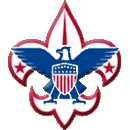| MERIT BADGES |
|
|
|
|
| Note: Eagle Required are in Italics |
"A"
American
Business
American Culture
American Heritage
American Labor
Animal Science
Archaeology
Archery
Architecture
Art
Astronomy
Athletics
Atomic Energy
Auto Mechanics
Aviation
"B"
Backpacking
Basketry
Bird Study
Bugling
"C"
Camping
Canoeing
Chemistry
Cinematography
Citizenship
Community*
Citizenship Nation*
Citizenship World*
Climbing
Coin Collecting
Collections
Communications*
Computers
Cooking
Crime Prevention
Cycling*
"D"
Dentistry
Disability Awareness
Dog Care
Drafting
"E"
Electricity
Electronics
Emergency
Preparedness**
Energy
Engineering
Entrepreneurship
Environmental
Science*
"F"
Family Life*
Farm Mechanics
Fingerprinting
Fire Safety
First Aid*
Fish & Wildlife Mgmt.
Fishing
Fly Fishing
Forestry
"G"
Gardening
Genealogy
Geology
Golf
Graphic Arts
"H"
Hiking
Home Repairs
Horsemanship
"I"
Indian Lore
Insect Studies
"J"
Journalism
"K"
"L"
Landscape Architecture
Law
Leatherwork
Lifesaving**
"M"
Mammal Study
Medicine
Metalwork
Model Design & Building
Motorboating
Music
"N"
Nature
"O"
Oceanography
Orienteering
"P"
Painting
Personal Fitness**
Personal Management*
Pets
Photography
Pioneering
Plant Science
Plumbing
Pottery
Public Health
Public Speaking
Pulp and Paper
"Q"
"R"
Radio
Railroading
Reading
Reptile & Amphibian Study
Rifle Shooting
Rowing
"S"
Safety
Salesmanship
Scholarship
Sculpture
Shotgun Shooting
Skating
Skiing
Small Boat Sailing
Soil & Water
Conservation
Space Exploration
Sports**
Stamp Collecting
Surveying
Swimming**
"T"
Textile
Theatre
Traffic Safety
Truck Transportation
"U"
"V"
Veterinary Medicine
"W"
Water Skiing
Weather
Whitewater
Wilderness Survival
Wood Carving
Woodwork
"X"
"Y"
"Z"
 Chemistry
ChemistryRequirements 1996 |
- Define chemistry and tell what chemicals are.
- Make a list of 10 chemicals found in your home and their use.
- Tell how chemicals in your home are safely stored and how to dispose of them safely.
- Tell the difference between a chemical reaction and a physical change.
- Tell what analytic chemists do. Do THREE of the following:
- Prepare an indicator from a plant leaf or bloom. Show that it works when vinegar neutralizes baking soda solution.
- Compare the strengths of 5 percent solutions of baking soda and borax by titrating each with vinegar.
- Test two different bits of food for starch and protein.
- Compare the amounts of vitamin C in two kinds of fruit juice.
- Show that an ink or food color has two or more colors by using paper chromatography.
- Define biochemistry.
- Write the simple equation for photosynthesis. Explain what parts sunlight and chlorophyll play in it. Give the names and symbols of the three main parts of a 10-6-4 fertilizer. Explain what each one does for plants. Draw from memory a sketch of the carbon dioxide-oxygen cycle.
- Explain what oxygen does in the body of an animal. Describe how oxygen, carbon dioxide,
and carbon monoxide are carried in the body. Describe the chemical changes taking place
when:
- Vegetables cook
- Meat cooks
- Bread dough rises
- Bread bakes
- Bread is chewed
- Define inorganic chemistry. Carry out an experiment to show three different ways of protecting iron or steel from rusting. Tell why aluminum doesn't rust the way iron does. Do an experiment in which one metal makes another metal deposit from solution. Explain what takes place in terms of the activity series of metals.
- Define organic chemistry.
- What are organic chemicals?
- Name three organic chemicals.
- Tell the difference between polar and non-polar.
- Show how polar and non-polar substances do not mix.
- Define physical chemistry.
- Construct a Cartesian diver.
- Explain why the medicine dropper sinks to the bottom when the sides are squeezed.
- Define pollution.
- Name two chemicals that cause air, water, or solid waste pollution near your home. Tell where these pollutants might have come from. Find one way to control one of these. Do one test to show that air or water is polluted.
- Do ONE of the following:
- Write the formula for ozone. Tell where it is found. Tell how it is both a pollutant and also necessary for a healthy environment.
- Write the formula for carbon dioxide. How can it cause the greenhouse effect?
- Write the formula for sulfur dioxide. Explain what acid rain is. What does pH measure? Measure the pH of rain or a body of water near your home. Tell how acid rain can be prevented.
- Do ONE of the following:
- Visit an industrial plant that makes chemical products or uses chemical processes, and describe the processes used. What, if any, pollutants are produced and how are they handled?
- Visit a laboratory or business that uses chemicals and find out how and why chemicals are used.
- Visit a county agent to learn how chemistry is meeting farm problems of soil fertility and crop pests.
- Describe two different kinds of work done by chemists, chemical engineers, and chemical technicians. Explain the differences in college courses for training each of these three kinds of people.
|
||||||
Last Update May 15, 2023

.jpg)
